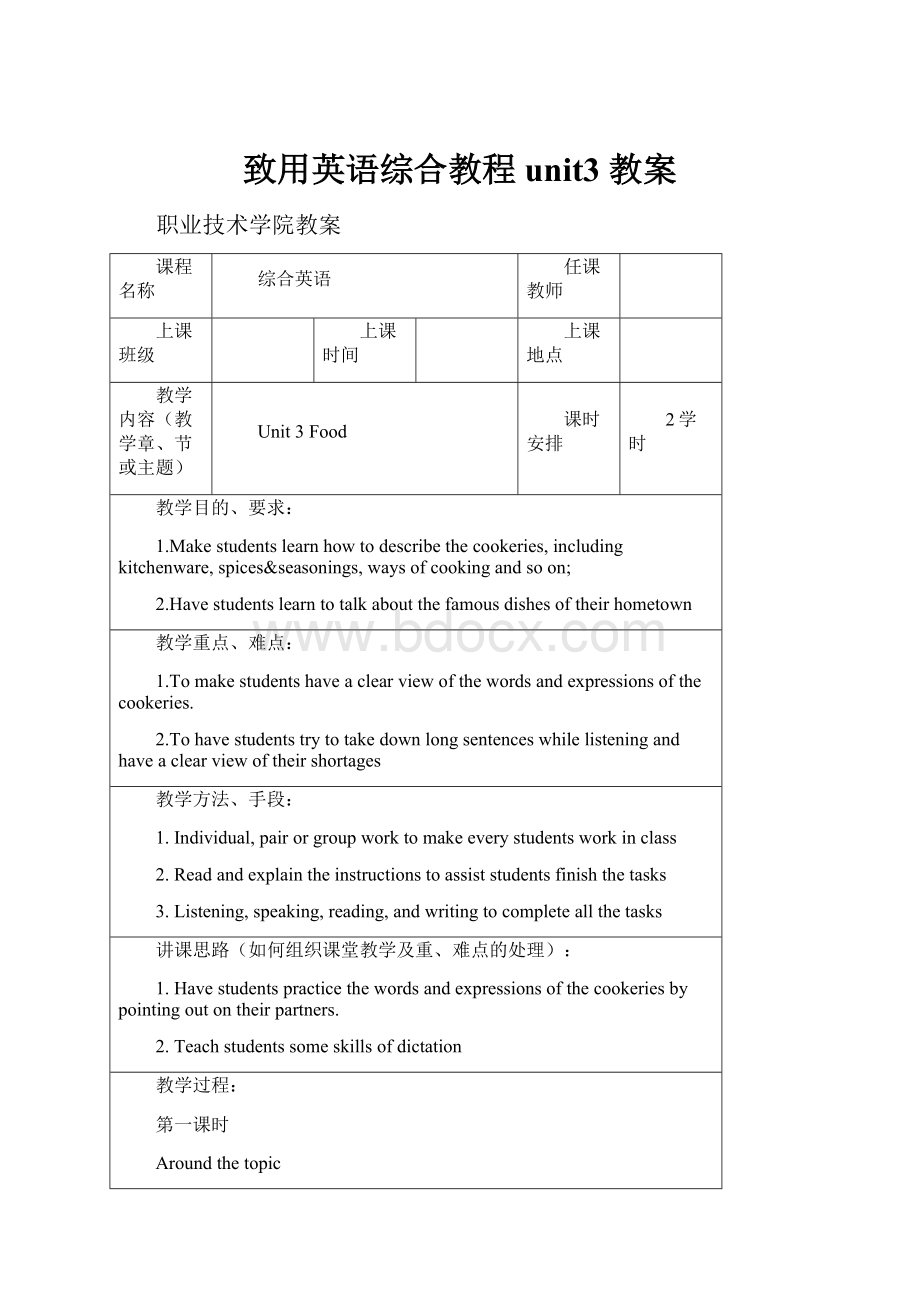致用英语综合教程unit3 教案.docx
《致用英语综合教程unit3 教案.docx》由会员分享,可在线阅读,更多相关《致用英语综合教程unit3 教案.docx(16页珍藏版)》请在冰豆网上搜索。

致用英语综合教程unit3教案
职业技术学院教案
课程名称
综合英语
任课教师
上课班级
上课时间
上课地点
教学内容(教学章、节或主题)
Unit3Food
课时安排
2学时
教学目的、要求:
1.Makestudentslearnhowtodescribethecookeries,includingkitchenware,spices&seasonings,waysofcookingandsoon;
2.Havestudentslearntotalkaboutthefamousdishesoftheirhometown
教学重点、难点:
1.Tomakestudentshaveaclearviewofthewordsandexpressionsofthecookeries.
2.Tohavestudentstrytotakedownlongsentenceswhilelisteningandhaveaclearviewoftheirshortages
教学方法、手段:
1.Individual,pairorgroupworktomakeeverystudentsworkinclass
2.Readandexplaintheinstructionstoassiststudentsfinishthetasks
3.Listening,speaking,reading,andwritingtocompleteallthetasks
讲课思路(如何组织课堂教学及重、难点的处理):
1.Havestudentspracticethewordsandexpressionsofthecookeriesbypointingoutontheirpartners.
2.Teachstudentssomeskillsofdictation
教学过程:
第一课时
Aroundthetopic
1.Dailyreport
Inthispart,some(oneortwo)studentsarerequiredtogiveaspeechaboutsomecurrentaffairs,sothattheycansearchforsomeinformationofitfromtheinternetorsomeotherMedias
.
2.LanguageStructures
A.Yourideas
Thisactivityisdesignedtoarousestudents’interestinthetopicoffood.Studentsmayfindthequestionsinthissectionstraightforward,butnotsoeasytogettherightanswers.Allowstudentsacoupleofminutestoexchangeideaswithpeerswithpeersbeforeaskingthemtoanswerquestions.Oryoumaydesignotheractivities.Playingagameofcompetitionbetweenboysandgirlsisnotabadone.
B.Vocabulary
Theaimofthissectionistoletstudentslearnsomebasicwordsusedtodescribe“food”.Actually,therearemanymoreadjectivesthatcangowiththenoun“food”.Forexample,fresh,frozen,tasty,plain,tasteless,natural,salted,pickledandsmoked.Askstudentstolookformoreandmakesentenceswiththesewordsashomework.
第二课时
C.Listeningandspeaking
Thissectionaimstodevelopstudents’listeningandspeakingabilities.Thelisteningpartfocusesonnaturalandhealthyfood.Letstudentslistentothetalktwice.Thefirsttimeisforgeneralunderstanding,andthesecondtimeforsomeforsomespecificinformation.Forthediscussionquestions,letstudentsworkingroups.Assignagroupleaderineachgroup.Afterthediscussion,askeachgrouptoreporttheirmainideastothewholeclass.Thetonguetwisterisforpronunciationandrhythmpractice.Getstudentstoreaditveryquickly,emphasizingtheimportanceofspeedandaccuracy.Don’toverdothispractice---keepitverybriefly.
习题(或复习思考题、讨论题):
1.Reviewwordsandexpressionsrelatedtothebodyparts.
2.PreviewReadingpart
教后记(教学反思、学生掌握情况及存在问题):
1.Studentslearnmostoftheexpressionsofthebodypartswhiletherearestillsometheyhaven’tgrasped.
2.Studentsaren’tusedtothedictation.Morepracticeisneeded.
备注:
1.页面大小可自行添减,每上一次课写一份上述格式教案,一次课一般2个学时。
2.近三年参加工作的青年教师必须写详案。
3.手写教案格式参照表格内容。
职业技术学院教案
课程名称
综合英语
任课教师
上课班级
上课时间
上课地点
教学内容(教学章、节或主题)
ReadingComprehension
Foodtoputyouinapartymood
课时安排
2学时
教学目的、要求:
1.Tomakestudentshaveaclearviewofthestructureofthepassage.
2.Tohavestudentslearntheauthor’spointofviewofthefoodwhichcanstimulatepeople;
3.Tomakestudentsmasterthekeywordsandexpressionsinthepassage.
教学重点、难点:
1.MakingstudentshavetheabilitytolearnandgraspthemainideaoftheReadingIbeforeorwithoutthehelpoftheteacher,andbeabletomakeuseoftheirownwordstosummarizeit.
2.Totrainstudents'readability,remindthemofdeveloptheabilityof"visualizingit"(seeitinthemind)whenreadastory,whenhelpsthemremembertheplotclearly.
3.Tohelpstudentsmasterwordsandexpressionsinthisarticle
教学方法、手段:
1.Talkingtoimprovestudents'speakingability.
2.Discussiontomakeeverystudentworkinclass.
3.Practicetogetstudentsmasterwhattheyhavelearnt
讲课思路(如何组织课堂教学及重、难点的处理):
1.Leadstudentstothetopicbydiscussingthepre-readingquestions.
2.Visualizethedescriptioninthetext,andconnectitwithstudents'ownexperienceoflearningEnglish.
3.Explainthelanguagepointsclearlyandcarefully.
教学过程:
第一课时
StepIgreetingandlead-in
1.Greetthestudentsasusual
2.Lead-in:
Dailyreport
StepIIwarm-up
Pre-readingtasks
a.Readtheinstructionsasaclass.
b.Dividestudentsintogroups,askthemtodiscussthequestions.
c.Activatetheirknowledgeandencouragethemtosharewitheachother.
d.Getsomefeedbackwhentheyfinish.
StepIIIReadingcomprehension
a.Learnthenewwordsandexpressionsofthisarticle
1.Somestudentsareinvitedtoreadtheminturn.
2.Theteachercorrectsstudents'mistakesinpronunciation.
3.Thestudentsreadthemtogether.
b.ListeningtotherecordofthisarticleandfinishexerciseAofansweringthefollowingquestions.
a.Supposeyouareplanninganinformalpartywithsomedrinksandsnacks.
Whatkindsoffoodanddrinkswouldyouliketoprovide?
Why?
b.Haveyoueverheardthatsomefoodanddrinkscanstimulatethenervoussystemandmakepeopletalkmorethanusual?
Listsomeifyouknow.
第二课时
Languagepoints
1.stimulatev.toexcite(thebodyormind)
e.g.Herinterestinartwasstimulatedbyherfather.
stimulatesomebodytodosomething
e.g.Aninspiringteachercanstimulatestudentstosucceed.
2.depressedadj.veryunhappy
e.g.Shefeltlonelyanddepressed.
depressedatsomething
e.g.Iwasdepressedatthethoughtofallthehardworkahead.
3.resultin:
tomakesomethinghappen;cause
e.g.Thisaccidentresultedinthedeathoftwopassengers.
resultfrom:
Ifsomethingresultsfromsomethingelse,itiscausedbyit.
Eg:
Wearestilldealingwithproblemsresultingfromerrorsmadeinthepast.
4.herbn.aplantwhichisusedtomakefoodtastestronger
e.g.Sprinklethedishwithchoppedfreshherbs.
5.spicen.amaterialusedforaddingatastetofoods
e.g.Pepperandnutmegarespice.
6.delightv.togivesomeonegreatsatisfactionandenjoyment
e.g.Herfabulousrecipeswilldelightanyonewholovechocolate.
delightsomebodywithsomething
e.g.Heisdelightingaudienceswithhiswitandhumour.
7.enlivenv.tomake(peopleorevents)moreactive,spirited,orcheerful
e.g.Humourcanhelpenlivenadullsubject.
8.outlawv.todeclare(something)unlawful
e.g.Thebillwouldhaveoutlawedseveraltypesofguns.
习题(或复习思考题、讨论题):
1.Letstudentsreviewthewholepassageandhaveaclearviewofthestructureofit.
2.Masterthewordsandexpressionsinthepassage
3.PreviewtheLanguageinusePart
教后记(教学反思、学生掌握情况及存在问题):
1.Studentshadahotdiscussiononthepre-readingquestions.
2.TheycouldconnectthecontentofthetextwiththeirownexperienceofEnglishlearning.
3.Somesentencesinthetextweredifficultforstudentstounderstand,whichneedtobeexplainedclearly.
4.Someofthewordswereunfamiliartostudents,exampleshadtobegiventohelpthemunderstandthem.
备注:
1.页面大小可自行添减,每上一次课写一份上述格式教案,一次课一般2个学时。
2.近三年参加工作的青年教师必须写详案。
3.手写教案格式参照表格内容。
职业技术学院教案
课程名称
综合英语
任课教师
上课班级
上课时间
上课地点
教学内容(教学章、节或主题)
Vocabularyandstructure
Languageinuse
课时安排
2学时
教学目的、要求:
1.Letstudentsgrasp:
Grammar:
Tagquestions
2.Havestudentsdotherelatedexercises.
教学重点、难点:
1.Grammar:
Tagquestions
2.Havestudentsmakegooduseofthegrammarpoints.
教学方法、手段:
1.ExplanationtoassiststudentshaveagoodunderstandingofTagquestions.
2.Readandexplaintheinstructionstoassiststudentsfinishthecorrespondingexercises.
讲课思路(如何组织课堂教学及重、难点的处理):
1.GivestudentssomeexamplesofTagquestions,askthemtodistinguishthem.
2.Leadintothetopic,andintroduceTagquestions.
3.Checkstudents'masterofTagquestionsbytheexercisesprovided.
教学过程:
第一课时
StepIGreetingandlead-in
a.Greetthestudentsasusual
b.Lead-in:
Dailyreport
StepIIWarm-up
Testyourgrammar
a.AskstudentstoworkinsmallgroupsandtrytogeneratesomebasicrulesofTagquestions
b.Getsomefeedbackfromstudentsandthenstartadiscussion.
c.LeadstudentsintothetopicofTagquestions.
Questiontagsareshortadditionstosentences,usedtoaskforagreementorconfirmation.Afternegativestatements,weusuallyusetheordinaryinterrogative,
forexample:
Anncan’tswim,canshe?
Thatisn’tTom,isit?
Afteraffirmativestatements,weusuallyusethenegativeinterrogative,forexample:
Peterhelpedyou,didn’the?
Marywasthere,wasn’tshe?
1. 陈述部分句式用Iam...,附加疑问部分用aren’tI。
例如:
Iamlate,aren’tI?
Iamyourfriend,aren’tI?
2. 陈述部分句式用Iwish...,附加疑问部分用mayI。
例如:
Iwishtogohome,mayI?
IwishIwereyou,mayI?
注意含wish句子的附加疑问句前后两部分均为肯定式,主语与wish的主语一致。
3. 陈述部分句式为Letme...,附加疑问则用willyou 或mayI,而Let's...,则用shallwe,Letus...,则用willyou。
例如:
Letmehelpyou,mayI?
Letmedoit,willyou?
Let’sgohome,shallwe?
Letusdoitbyourselves,willyou?
当let接第三人称宾语时,用willyou。
例如:
Lethimcomein,willyou?
第二课时
1.Introducesomewritingskills
2.Letstudentswriteashortpassageaccordingtotheskillslearned.
习题(或复习思考题、讨论题):
a.ReviewwhatwelearninclassaboutTagquestions.
b.Previewtheleftthreesections:
LanguageinuseandProject
教后记(教学反思、学生掌握情况及存在问题):
1.Tagquestionsareimportantgrammarpointsforstudents,theymaybeconfusedbytheuseofthem,teacherhadtoexplaintothemclearly,aswellasgivethemenoughexercises.
2.Letstudentslearnthewritingskillsandmakeuseofthemsmoothly.
备注:
1.页面大小可自行添减,每上一次课写一份上述格式教案,一次课一般2个学时。
2.近三年参加工作的青年教师必须写详案。
3.手写教案格式参照表格内容。
职业技术学院教案
课程名称
综合英语
任课教师
上课班级
上课时间
上课地点
教学内容(教学章、节或主题)
LanguageinuseandP